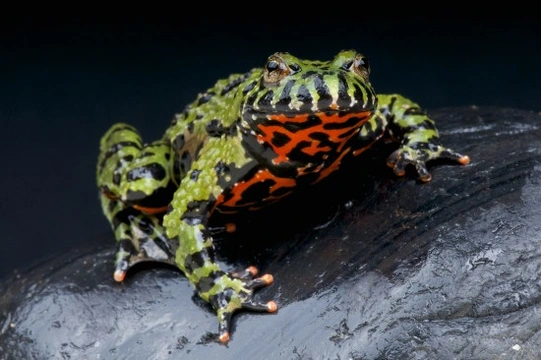
Choosing and caring for a Fire Belly Toad
The Fire Belly Toad is an amphibian that can be kept very successfully in captivity, and it is not unheard of for the species to live for as long as thirty years. The name “toad” is actually incorrect, as the Fire Belly is really a frog, but their bumpy skin gives them a toad-like appearance, which ultimately led to the misnomer!
In the wild, the Fire Belly Toad lives in warm, humid regions within a mostly aquatic environment, and they tend to dwell among thick vegetation and in shallow ponds. The skin of the Fire Belly Toad is slightly toxic to the touch, and so handling should be kept to a minimum, both for your own good and to protect the delicate balance of the frog’s skin.
If you are interested in keeping frogs or toads and are wondering if a Fire Belly might be the right choice for you, read on for some more information.
Tank and habitat
In order to keep your Fire Belly Toad happy and well, you must first begin by providing them with the appropriate living environment!
Choose an aquatic or amphibian tank, and ensure that there is plenty of space to provide undergrowth for your toad, as well as room to move around freely. As the Fire Belly needs both land and water, the substrate of the tank should be set up to provide both of these environments, with about 40% of the floor space dedicated to land, and the remaining 60% to water. Use rocks and ornaments to provide land areas, which your frog can use to get in and out of the water when they want to. Both the water part and the land part of the tank should encompass some hiding places and areas of cover, to make your frog feel secure.
In terms of the depth of the water in the tank, this need not be deep; anything between 5-10cm deep is perfect. Use sphagnum moss as the substrate for the land areas of the tank, which will provide plenty of opportunities for your frog to burrow and hide if they wish to, and to aid with keeping their skin supple.
Fire Belly Toads do not usually require a tank heater if your indoor temperature is ambient and not cool, but a light for the tank may be required to allow you to see your frog properly. Take care to monitor the tank temperature to ensure that it is neither too hot nor too cold, particularly when the light is on.
Feeding a Fire Belly Toad
Fire Belly Toads need to be provided with live food, as if they cannot see movement they will have a hard job identifying what they are supposed to eat! A good, balanced diet for the Fire Belly Toad will include wax worms, mealworms, crickets and phoenix worms, all of which can easily be bought from specialist exotics retailers and sometimes over the internet. Phoenix worms in particular are good for Fire Belly Toads, as they are rich in essential calcium.
Before you feed these insects to your toad, you will need to gut-load them with a nutritional complex, to ensure that the insects provide the ultimate nutrition that your frog needs to thrive. When you place your frog’s food into the tank, keep it away from the most brightly lit areas of the tank, as looking directly into the light source may harm your frog’s eyes.
Handling
If at all possible, do not handle your frog with your bare hands, as this is not good for either of you! The skin of the Fire Belly Toad is mildly toxic and can cause irritations of the skin, so if you do need to re-house or move your frog about, wear gloves or try to scoop them into a container to make the move.
Handling your frog can also prove damaging to them too, as the salt on your hands can interfere with the natural balance of their skin’s moisture, and can also very much upset your frog and cause them to become wound up or stressed out.
How to pick a healthy Fire Belly Toad
Larger exotic retailers and even some pet shops will stock Fire Belly Toads on occasion, so once you have done your research, you should be able to find some specimens for sale. Fire Belly Toads are often kept in pairs to provide company and a more natural lifestyle for each other, so consider buying two and not just one!
Look for frogs that look at you and move if you tap the glass, and only pick lively, alert-looking specimens. While the colours of the Fire Belly Toad can vary considerably, try to pick the brightest looking ones available, as these will generally be the most healthy. Transport your frog home carefully, and ensure that you have their tank all set up ready to receive them before you get them home.



